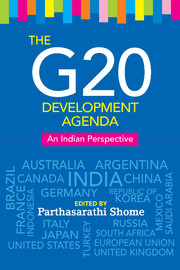Book contents
- Frontmatter
- Contents
- List of Tables and Figures
- Preface
- Section 1 Introduction
- Section 2 The Development Agenda
- 2 Commodity Market Policy for Food Security – The Road Ahead for G20
- 3 Recycling Global Surpluses for Infrastructure Investment in Emerging Market Economies
- 4 G20: Impact of the Crisis with Special Reference to India and International Burden Sharing
- 5 India's Growth Prospect: Structural Impediments
- Section 3 Energy Security and Environmental Sustainability
- Contributors
- Index
3 - Recycling Global Surpluses for Infrastructure Investment in Emerging Market Economies
from Section 2 - The Development Agenda
Published online by Cambridge University Press: 05 May 2015
- Frontmatter
- Contents
- List of Tables and Figures
- Preface
- Section 1 Introduction
- Section 2 The Development Agenda
- 2 Commodity Market Policy for Food Security – The Road Ahead for G20
- 3 Recycling Global Surpluses for Infrastructure Investment in Emerging Market Economies
- 4 G20: Impact of the Crisis with Special Reference to India and International Burden Sharing
- 5 India's Growth Prospect: Structural Impediments
- Section 3 Energy Security and Environmental Sustainability
- Contributors
- Index
Summary
Global imbalances have mounted in the world eccnomy since 1996, in the form of surpluses in some countries with large deficits in other nations, chiefly the United States. Starting around the mid-90s, growing surpluses mounted in countries like China, Japan and Germany, offset by a widening current account deficit in the United States. Combined global reserve holdings grew more than 20 per cent annually from 2001–02, falling steeply to nearly half the rate in 2008 in reflection of the sharp contraction in world trade and cross-border investments. The imbalances however, started rising again in 2010. According to McKinsey Global Institute (2011), central bank foreign reserves were the fastest growing components of global foreign investment assets in 2010, reaching US$ 8.7 trillion; nearly 9 per cent of the world's financial stock was invested in government bonds and other low-risk securities.
Several factors explain the accumulation of these world imbalances. For one, the United States followed an increasingly lax monetary policy to counter its recession from 2000 onwards. Two, China pursued an aggressive, exportled growth strategy throughout the 90s and up to the 2008 crisis through an undervalued exchange rate leading to substantial accumulation of reserves. In the same period, commodity-exporting countries also accumulated surpluses to smooth terms-of-trade shocks and prevent setting in of ‘Dutch Disease’, i.e., a real appreciation-driven, expansion in domestic demand from rising export incomes that erodes productivity of the manufacturing sector, eventually resulting in falling exports as imports become more competitive.
Another factor prompting reserves’ accumulation is the increased capital mobility since the 90s that challenged most developing economies as capital controls began losing their grip while the frequency and intensity of financial crises rose. This triggered a wave of precautionary reserves’ accumulation as affected countries sought to ‘self-insure’ against future liquidity shocks (Eichengreen, 2004). After the East Asian Crisis of 1997–98, perceptions of an unfair international financial architecture rose too, adding further momentum as Asian nations created sizeable liquidity buffers and regional reserve pools.
- Type
- Chapter
- Information
- The G20 Development AgendaAn Indian Perspective, pp. 73 - 85Publisher: Cambridge University PressPrint publication year: 2015



